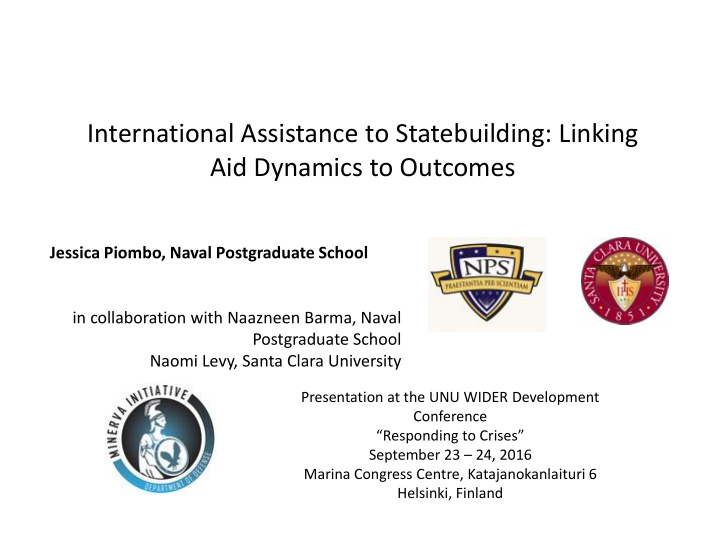



International Assistance to Statebuilding: Linking Aid Dynamics to Outcomes Jessica Piombo, Naval Postgraduate School in collaboration with Naazneen Barma, Naval Postgraduate School Naomi Levy, Santa Clara University Presentation at the UNU WIDER Development Conference “Responding to Crises” September 23 – 24, 2016 Marina Congress Centre, Katajanokanlaituri 6 Helsinki, Finland
Three conceptual steps to improve our understanding of how peace is achieved in post-conflict countries • Disentangle the goals of statebuilding and peacebuilding – Statebuilding and peacebuilding are dynamic processes that affect distinct sets of outcomes: “ state coherence” and the “ depth of peace” • Examine the causal effects of international assistance on state strength and depth of peace outcomes – What aspects of “ aid dynamics” are most conducive to fostering the desired outcomes? • Conduct an empirical study through the lens of public service delivery – An arena in which to examine state – society and government – development partner interactions
What is the causal effect of the dynamics of aid on state coherence and the depth of peace?
An empirical investigation underpins this “constructively critical” approach to peacebuilding • • Countries Three sets of interviews – Cambodia – External actors: International – Laos organizations, bilateral donors, – Uganda international NGOs – Public officials: Central ministry officials • Sectors and frontline public service providers – Education – Other domestic stakeholders: local – Health government officials; implementation – Public Works partners • Content analysis • Complementary large-N data collection process
Statebuilding Dynamics State Coherence Aid Dynamics • Authority • Level • Effectiveness • Purpose • Legitimacy • Administration Unpack this dimension: What are the causal dynamics?
Aid Dynamics Causal Mechanisms Impacts on State Coherence 1. Systems enhancement Positive 2. Resource mobilization 3. Long-term human capacity building 4. Skills transfer 5. Gap filling Ambiguous 6. Parallel systems 7. Substitution Negative 8. Impairment 9. Competitive systems 10. Rentier dynamics 11. Regime maintenance and/or securitization
State Coherence Outcomes: Positive Dynamics Leads to Mechanism • Increased human and • Systems institutional capacity, especially enhancement at the central levels • Resource – Policy development mobilization – Financial and regulatory systems • Long-term human – Sector-wide planning processes capacity building – Development of indigenous experts • Skills transfer • Government agencies that graduate from external support
State Coherence Outcomes: Ambiguous Dynamics Leads To: Mechanism • Extended service provision and • Gap-filling potentially enhanced effectiveness • Parallel effort via complementary service provision coordinated with government strategies. • May or may not affect dimensions of state coherence.
State Coherence Outcomes: Negative Dynamics Leads to Mechanism • Government choosing not to develop capacity in a sector • Substitution due to high external involvement • Impairment • Service delivery problems attributable to interruptions with and reliance on external funding; sapping the human • Overwhelming capacity of the government via competitive brain drain • Competition • Crowding out of the government in particular areas, either a sector or an issue of high interest in highly aided sectors like health – Government fails to develop effective capacity in the arenas – Policies and programs driven by development partner interests vs local initiatives – Patchiness and coordination challenges • Private provision detracting from government efforts
State Coherence Outcomes: Most Negative Dynamics Leads To: Mechanism • Aid substitutes for other revenue • Rentier effects sources and results in weakened • Regime maintenance bureaucratic and administrative capabilities. • Recipient regimes use foreign assistance to enhance their own extractive potential and security apparatus (substituting force for legitimacy)
State Coherence Outcomes: Contingent and Interactive Causality • Interactive effects between the causal mechanisms Direct interaction: substitution frees up resources → regime maintenance Staged interactions: 1. Parallel systems over time come to 2. C ompete with government systems as 3. The government s ubstitutes its activities outside of the sector; 4. Resulting in the degradation in the parts of the sector in which the development partners were not active.
Whether statebuilding and peacebuilding are complementary is an empirical question Statebuilding can help to build more inclusive societies and legitimate political settlements centered on the state apparatus and the state – society interface. BUT Sometimes building state coherence to deliver governance can create distributional/identity tensions that undermine post-conflict recovery and conflict resilience. AND Achieving greater state coherence may require a different form of political settlement from deepening the peace.
Questions? For more on the project, please visit http://www.peaceandstatebuilding.net/
Recommend
More recommend